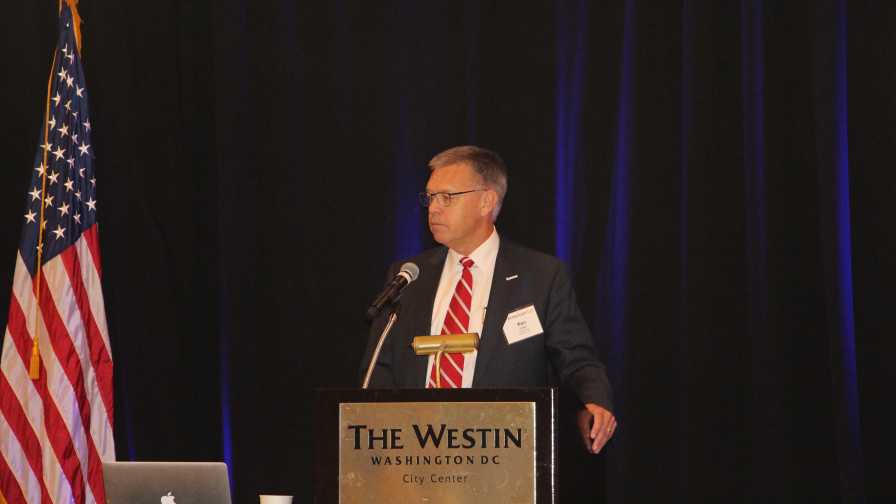Lawmakers Continue to Seek Labor Solutions for Ag

AmericanHort President and CEO Ken Fisher addresses attendees of a previous Impact Washington event.
Photo: Laura Drotleff
Labor and workforce issues continue to vex most greenhouse and nursery growers. We see both clouds and some glimmers of hope on the issue horizon. There is a possibility of helpful action by Congress, and both the threat of enforcement and the hope of helpful regulatory reform from the Trump administration. To better understand what’s possible, let’s unpack each of these possibilities.
Legislative reform is the single best way to solve the problem and bring solutions and integrity to our immigration system. Agriculture is united behind the broad elements of a solution — a reliable, market-based ag worker visa program most likely achieved through fixing the H-2A program, and options for experienced but improperly documented ag workers to earn legal presence with agricultural work authorization.
At present, the Senate is largely deferring to the House to try to tackle the issue first. The House, for its part, has already passed a package of bills addressing the fate of the so-called Dreamers, as well as roughly 300,000 individuals, mostly from Central America and Haiti, living in the U.S. with temporary protected status.
Next on the big list of priorities for the House Judiciary Committee and Immigration Subcommittee Chair Zoe Lofgren (D-CA) is agriculture and farmworkers. She is presiding over a bipartisan negotiation involving several other lawmakers, and farm employer and farmworker advocates. AmericanHort is fortunate to be one of only a few organizations on the negotiating team, recognizing our longstanding credibility and thought leadership on the issue.
The negotiations have progressed quickly on some issues and more slowly on others. The biggest remaining sticking points are how to set wages for H-2A visa program workers, and whether and how to open up access to H-2A for jobs that are not inherently seasonal (currently defined by the Labor Department as 10 months or less). Time is running out to complete a deal and move it through the House before the August recess; the more likely scenario would see the introduction of a compromise bill — if workable compromise can be found — during September.
Meanwhile, there are other marker bills out there, including a limited seasonal visa program reform bill by Sen. Rand Paul (R-KY) and an outline of a proposal by Rep. Ted Yoho (R-FL). While such efforts could be helpful, the Lofgren process is really where the action and potential progress are to be found.
Improvements to H-2A May Be on the Way
On the administrative or regulatory front, first the good news. As of this writing, we are expecting publication of the Federal Register notice (technically, a “notice of proposed rulemaking”) detailing and seeking public comment on potential modernizing improvements to the H-2A program. This initiative, championed by Agriculture Secretary Sonny Perdue, sprouted and took root after President Trump met with 15 farmers at the White House in April 2017. Involved in the effort are the Departments of Agriculture, Labor, Homeland Security, and State. But ag and labor are primary.
Until we see the notice, we won’t know precisely which H-2A improvements are going to be proposed and which will be deemed too politically controversial or only achievable through legislation. But with more growers having to consider H-2A, all changes that make the process more reliable, reduce agency duplication of effort, or contain costs, will be welcomed (and, possibly subject to legal challenge). Which is why, at the end of the day, we need statutory fixes that only Congress can attain.
No-Match Enforcement Letters Linger
On a more somber note, the enforcement situation for employers continues to grow more complicated and worrisome. Whether or not presidential threats of mass deportation materialize, worksite enforcement is happening. We’ve received reports of a spate of I-9 audits in Minnesota reminiscent of similar audits that resulted in a high-profile raid in Northern Ohio one year ago. And the Social Security Administration has injected confusion into the employer community with a restart of the so-called no-match letters.
The latest batch of no-match letters, sent to thousands of employers beginning this past April, directed employers to go online to determine which employees had problematic Social Security numbers. In detailed legal guidance to members, AmericanHort cautioned that going to the recommended website could open Pandora’s box and put employers in an untenable situation with respect to workers’ authorization. We also noted the Social Security Administration does not have the authority to mandate that employers take the recommended steps. Our position was later vindicated in a Social Security Administration response to a congressional inquiry.
In short, it’s a mix of concerning and promising news. It’s also worth noting that growers will have a chance to directly advocate for progress on these critical issues at the AmericanHort Impact Washington legislative summit this September. You can find additional information on this premier horticulture industry advocacy event at AmericanHort.org under the Events tab. Until then, best wishes for the summer.










